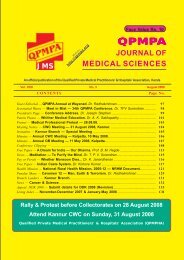QPMPA Journal September 2011 - Qualified Private Medical ...
QPMPA Journal September 2011 - Qualified Private Medical ...
QPMPA Journal September 2011 - Qualified Private Medical ...
Create successful ePaper yourself
Turn your PDF publications into a flip-book with our unique Google optimized e-Paper software.
views<br />
○ ○ ○ ○ ○ ○ ○ ○ ○ ○ ○ ○ ○ ○ ○ ○ ○ ○ ○ ○ ○ ○ ○ ○ ○ ○ ○ ○ ○ ○ ○ ○ ○ ○ ○ ○ ○ ○ ○ ○ ○ ○ ○ ○ ○ ○ ○ ○ ○ ○ ○ ○ ○ ○ ○ ○ ○ ○ ○<br />
death; end or beginning<br />
“The care of human life and happiness<br />
and not their destruction is the first<br />
and only legitimate object of good<br />
government.”... Thomas Jefferson<br />
“There is no quality of life when the<br />
patient is dead.”... A nurse<br />
Death is the termination of the biological<br />
functions in a living organism. The<br />
word refers both to the particular processes<br />
of life’s cessation as well as to the<br />
state of a formerly living body. Phenomena,<br />
which commonly bring about death,<br />
include predation, malnutrition, accidents<br />
resulting in terminal injury, disease<br />
and an ‘act of God’.<br />
The nature of death has been a central<br />
concern of the world’s religious traditions<br />
and philosophical enquires. A belief<br />
in some kind of afterlife or rebirth<br />
has been a central aspect of religious<br />
belief. Scientific enquiry is yet to grapple<br />
with the origin and nature of consciousness<br />
and agrees any such view about its<br />
existence or non-existence after death<br />
remains speculative as far as science is<br />
concerned.<br />
<strong>Medical</strong> science is at a loss to locate where<br />
consciousness exists; is it inside or outside<br />
the body. Neurologists think it is in<br />
brain. However, modern outlook is that<br />
if neurologists want to test ‘the higher<br />
functions’ in a living entity they must do<br />
it in ‘higher areas’ above the body; not<br />
inside it.<br />
Senescence<br />
Almost all animals fortunate enough to<br />
survive hazards of their existence eventually<br />
die from senescence. The only exception<br />
is jellyfish — Turritopsis<br />
nutricula, thought to be immortal in effect.<br />
Causes of death in humans as a<br />
result of intentional activity include suicide,<br />
homicide and war. From all causes,<br />
roughly 1,50,000 people die around the<br />
world each day.<br />
Physiological death is now seen as less<br />
an event than a process: conditions once<br />
considered indicative of death are now<br />
reversible. Where in the process, a dividing<br />
line is drawn between life and death,<br />
depends on factors beyond the presence<br />
or absence of vital signs. In general, clinical<br />
death is neither necessary nor sufficient<br />
enough for a determination of legal<br />
death. A patient with working heart and<br />
lungs and determined to be brain dead<br />
can be legally dead without clinical death<br />
occurring. Precise medical definition of<br />
death becomes more problematic as scientific<br />
knowledge and medicine advance:<br />
a strange paradox.<br />
dr. k. sasidharan<br />
Signs of death or strong indications that<br />
a person is no longer alive are:<br />
Cessation of breathing<br />
No pulse (cardiac arrest)<br />
Pallor mortis, paleness that happens<br />
in the 15–120 minutes after death.<br />
Liver mortis, a settling of the blood in<br />
the lower (dependent) portion of the<br />
body.<br />
Algor mortis, the reduction in body<br />
temperature following death. This is generally<br />
a steady decline until matching<br />
ambient temperature.<br />
Rigor mortis, the limbs of the corpse<br />
become stiff (Latin rigor) and difficult to<br />
move or manipulate.<br />
Decomposition, the reduction into<br />
simpler forms of matter, accompanied by<br />
a strong, unpleasant odour.<br />
The concept of death is a key to human<br />
understanding of the phenomenon.<br />
There are many scientific approaches to<br />
the concept. For example, brain death,<br />
as practiced in medical science, defines<br />
death as a point in time during which<br />
○ ○ ○ ○ ○ ○ ○ ○ ○ ○ ○ ○ ○ ○ ○ ○ ○ ○ ○ ○ ○ ○ ○ ○ ○ ○ ○ ○ ○ ○ ○ ○ ○ ○ ○ ○ ○ ○ ○ ○ ○ ○ ○ ○ ○ ○ ○ ○ ○ ○ ○ ○ ○ ○ ○ ○ ○<br />
128<br />
<strong>QPMPA</strong>.JMS . Vol. XXV . No. 3 . June-Sept. <strong>2011</strong>



